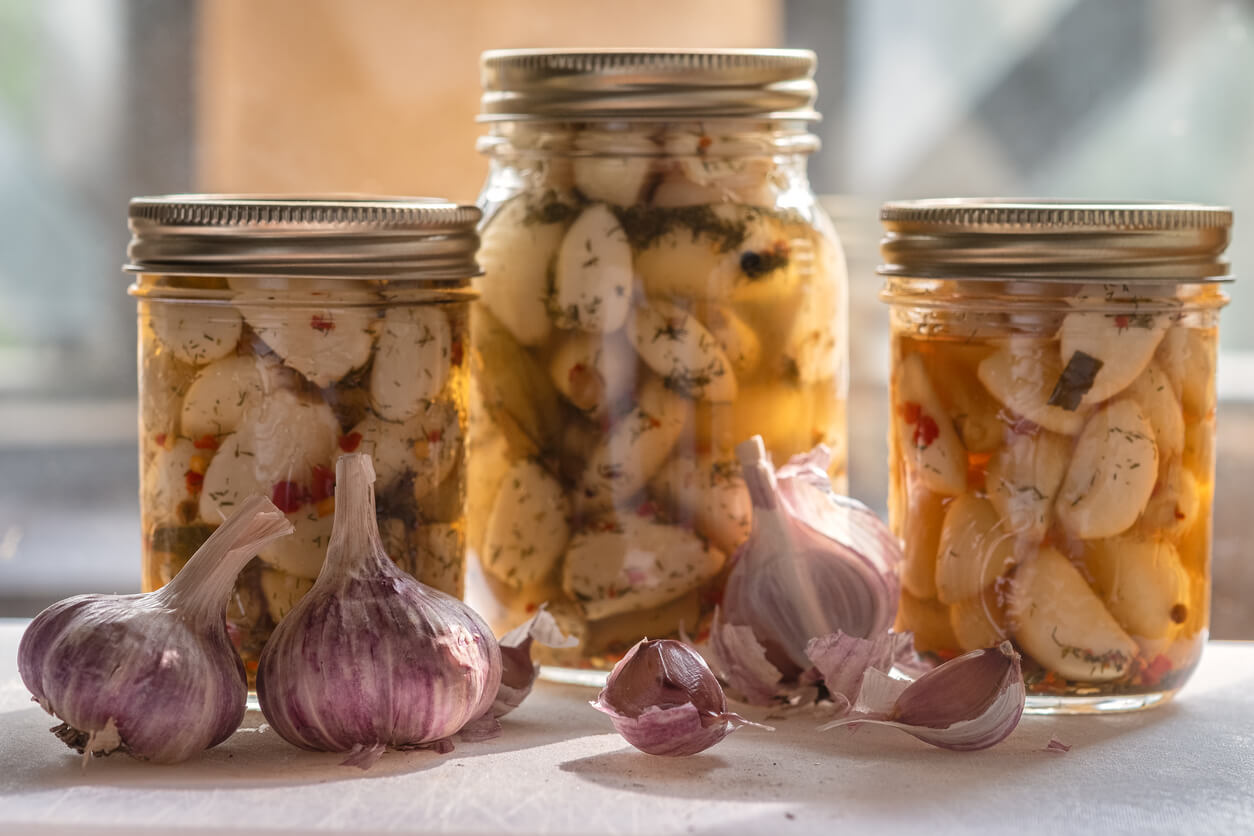
Fresh and Home Canned Pickled Red Russian Garlic
Garlic is one of the most versatile ingredients you can grow in your garden. It can be added to savory dishes, used as a condiment, and even enjoyed on its own. Luckily, it’s also relatively easy to store and preserve garlic from your harvest, which makes it simple to enjoy this flavorful vegetable all year round.
Storing Garlic
Once you have harvested your garlic, brush the dirt off the plants—don’t rinse them in water—and cut off the roots (they can absorb moisture and cause rotting). Place the plants in a cool, dry area away from the sun; you can lay them on a table or hang them to cure. You’ll know your garlic is fully cured when the stem dries out and the wrappings are papery. Cut the stems to about an inch at this point, and you can store your garlic in a cool, dark place for months. Be aware that softneck garlic stores longer than most hardneck varieties.
Softneck garlic will last for up to nine months if it can be stored in consistent 32-degree F temperatures, and up to two months if the temperature is 68 to 86 degrees F. Hardneck garlic will last stored for up to six months in temperatures under 60 degrees F. After this time, the garlic will begin to shrivel, and may even sprout. You can still use sprouted garlic, just cut and remove the sprout.
Preserving Garlic
One of our favorite ways to preserve garlic is by cooking it slowly in the oven for a few hours to create garlic confit, which can be spread on bread, enjoyed with cream cheese on a bagel, or used as a rub on chicken!
Although curing your garlic in this way is the best method for using it fresh in dishes, there are quite a few other ways to preserve garlic from the garden to make it last longer.
Freezing: To freeze garlic, simply peel, then mince or dice the cloves, spread them on a baking sheet, and freeze for an hour or two. Place the frozen cloves into an airtight container and store in your freezer. You can also freeze them whole!
Pickling: Another popular method of preserving garlic for storage is pickling it. You don’t need to pickle them alone either, use them with your cucumber pickles! To pickle garlic by itself:
Combine 1/4 cup of canning salt with 5 cups of vinegar in a large saucepan over medium heat. As the mixture begins to simmer, add 2 pounds of fresh garlic cloves into four sterilized pint jars with 1/4 teaspoon red pepper flakes and 1/2 cup fresh dill at the top, leaving half an inch headspace. Allow the solution to boil for 10 minutes or until it hits 180 degrees F before turning off the heat. Allow it to cool completely before transferring into the jars, and securely fastening the lids. To make the garlic last the longest, follow with a water bath for 10 minutes, then let sit on the counter to cool for 12 hours. Chill in the refrigerator for three weeks to fully pickle, then store sealed in the refrigerator for up to four months. Once a jar is open, it’s best to eat within one to two weeks.
When pickling garlic, it is not uncommon to see a bluish or turquoise color on the cloves. This is perfectly safe and should not cause any concern. To prevent discoloration of your garlic when pickling, ensure to use kosher salt or sea salt, which helps avoid iodine; opt for stainless steel/enamel cookware and utensils; store in dark places as sunlight can stimulate chlorophyll production; and make sure only distilled water is used instead of tap water, which contains trace minerals.
Dehydrating: If you have a dehydrator, garlic can be dried out and stored to last even longer than freezing or pickling. Simply chop the cloves finely and spread them on your drying trays to dehydrate. You can also dry them in an oven at 170 degrees F with the door slightly open—this will take around 12 to 18 hours, so make sure you check on it regularly! They taste great on salads!
There are many other ways to preserve garlic from your garden; these are just some of our favorites! Regardless of how you choose to store your garlic, we hope you enjoy this flavorful ingredient for months to come.
How do you store and preserve your garlic? Please tell us your favorite ways to preserve your harvest.


 Previous
Previous

